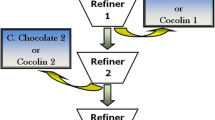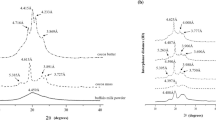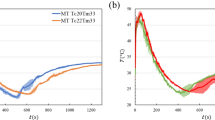Abstract
The relationship between the microstructural and rheological properties of white chocolate was studied during the main steps (mixing, pre-refining, refining, conching and tempering) of the manufacturing process. Laser light diffraction and light microscope techniques were used to study the particle size distribution (PSD) and the modifications of the network structure of the samples. Rheological parameters in terms of yield stress, apparent viscosity and thixotropy were evaluated by using a stress-strain controlled rheometer. The Casson and Windhab rheological models, which are widely used for dark and milk chocolate matrices, were used in order to explain better the rheological values obtained from the flow curves. Particle analysis revealed significant changes in the network structure during process. In particular, from the mixed sample to the refined one, a reduction in particle size was found; Sauter (D[3.2]) and Feret diameters decreased, the former from 18.6 to 6.67 μm and the latter from 320 to 33 μm. Consequently, an increase in the matrix aggregation was observed. The white chocolate samples obtained from the conching and tempering steps were characterized by the statistically lowest values of yield stress and apparent viscosity and by the weak structure. Moreover, the samples were well discriminated by both rheological models applied.



Similar content being viewed by others
References
Afoakwa, E. O., Paterson, A., & Fowler, M. (2008). Effects of particle size distribution and composition on rheological properties of dark chocolate. European Food Research and Technology, 226, 1259–1268.
Afoakwa, E. O., Paterson, A., Fowler, M., & Vieira, J. (2009). Microstructure and mechanical properties related to particle size distribution and composition in dark chocolate. Journal of Food Science and Technology, 44, 111–119.
Aguilera, J. M. (2005). Why food microstructure. Journal of Food Engineering, 67, 3–11.
Allen, T. (1997). Particle size measurements, ed. Chapman and Hall, London, 5th edn.
Baldino, N., Gabriele, D., & Migliori, M. (2010). The influence of formulation and cooling rate on the rheological properties of chocolate. European Food Research and Technology, 231, 821–828.
Beckett, S. T. (2010). The science of chocolate. London: RSC.
Black, D. L., Mc Quay, M. Q., & Bonin, M. P. (1996). Laser-based techniques for particle-size measurement: a review of sizing methods and their industrial applications. Progress in Energy and Combustion Science, 22, 267–306.
Chabbra, R. P. (2006). Non-Newtonian fluid behaviour. Bubbles, drops, and particles in non-Newtonian fluids. CRC Press: Boca Raton. Chapter 2.
Chevalley, J. (1991). An adaptation of the Casson equation for the rheology of chocolate. Journal of Texture Studies, 22, 219–229.
Coussot, P., & Ancey, A. (1999). Rheophysical classification of concentrated suspensions and granular pastes. Physical Review E, 59, 4445–4457.
Dhalenborg, H., Millquist-Fureby, A., Brandner, B. D., & Bergensthal, B. (2012). Study of the porous structure of white chocolate by confocal Raman microscopy. European Journal of Lipid Science and Technology, 114, 919–926.
Dhonsi, D., & Stapley, A. G. F. (2006). The effect of shear rate, temperature sugar and emulsifier on the tempering of cocoa butter. Journal of Food Engineering, 77, 936–942.
Directive 2000/36/EC of the European Parliament and of the Council of 23 June 2000 Relating to Cocoa and Chocolate Products Intended for Human Consumption, 2000 O.J. (L 197) 19.
Do, T.-A. L., Hargreaves, J. M., Wolf, B., & Mitchell, J. R. (2007). Impact of particle size distribution on rheological and textural properties of chocolate models with reduced fat content. Journal of Food Science, 72, 541–552.
Dolz, M., González, F., Delegido, J., Hernández, M. J., & Pellicer, J. (2000). A time dependent expresión for thixotropic areas. Application to aerosol 100 hydrogels. Journal of Pharmaceutical Sciences, 89, 790–797.
Glicerina, V., Balestra, F., Dalla Rosa, M., & Romani, S. (2013a). The influence of process steps on microstructural, rheological and thermal properties of dark chocolate. Journal on Processing and Energy in Agriculture, 17(2), 59–63.
Glicerina, V., Balestra, F., Dalla Rosa, M., & Romani, S. (2013b). Rheological, textural and calorimetric modifications of dark chocolate during process. Journal of Food Engineering, 119, 173–179.
Hugelshofer, D. (2000). Structural and rheological properties of concentrated suspensions mixed with an emulsion. Doctoral Thesis—Swiss Federal Institute of Technology (ETH) Zürich—Switzerland.
International Confectionery Association (ICA). (1973). Viscosity of chocolate. Determination of Casson yield value and Casson plastic viscosity (p. 10). London: OICC.
International Confectionery Association (ICA). (2000). Viscosity of cocoa and chocolate products. Analytical Method 46. CAOBISCO, rue Defacqz 1, B-1000 Bruxelles, Belgium.
IOCCC. (2000). Viscosity of cocoa and chocolate products. Analytical Method 46–2000. Geneva: International Office of Cocoa, Chocolate and Confectionary.
Izidoro, D. R., Scheer, A. P., Sierakowski, M. R., & Haminiuk, C. W. I. (2008). Influence of green banana pulp on the rheological behaviour and chemical characteristics of emulsion (mayonnaises). Swiss society of Food Science and Technology, 41, 1018–1028.
Jardim, D. C. P., Orse, A. G., Efraim, P., & De Moura, S. C. S. R. (2011). Kinetic of white chocolate loss. Procedia Food Science, 1, 1026–1030.
Larsson, R. G. (1999). The structure and rheology of complex fluids. New York: Oxford University Press.
Ludger, F., & Teixeira, A. (2007). Food physics: physical properties—measurement and applications. Springer.
Roopa, B. S., & Bhattacharya, S. (2009). Characterisation and modelling of time-independent and time-dependent flow behaviour of sodium alginate dispersions. International Journal of Food Science and Technology, 44, 2583–2589.
Samsudin, S., & Rahim, M. A. A. (1996). Use of palm mid-fraction in white chocolate formulation. Journal of the Science of Food and Agriculture, 71, 483–490.
Sato, A. C. K., & Cunha, R. L. (2009). Effect of particle size on rheological properties of jaboticaba pulp. Journal of Food Engineering, 91, 566–570.
Servais, C., Jones, R., & Roberts, I. D. (2002). The influence of particle size distribution on the processing of food. Journal of Food Engineering, 51, 201–208.
Servais, C., Ranc, H., & Roberts, I. D. (2004). Determination of chocolate viscosity. Journal of Texture Studies, 34, 467–497.
Sokmen, A., & Gunes, G. (2006). Influence of some bulk sweeteners on rheological properties of chocolate. Food Science and Technology-Leb, 39, 1053–1058.
Stortz, T. A., & Marangoni, A. (2013). Ethylcellulose solvent substitution method of preparing heat resistant chocolate. International Food Research, 51, 797–803.
Vercet, A. (2003). Browing of white chocolate during storage. Food Chemistry, 81, 371–377.
Vernier, F. (1998). Influence of emulsifier on the rheology of chocolate and suspension of cocoa and sugar particles in oil. Doctoral Thesis—Department of Chemistry, University of Reading.
Weipert, D., Tscheuschner, H. D., & Windhab, E. (1993). Rheologie der Lebensmittel, 452–457.
Ziegleder, G., Amanitis, A., & Hornik, H. (2004). Thickening of molten white chocolate during storage. LWT, 37, 649–656.
Author information
Authors and Affiliations
Corresponding author
Rights and permissions
About this article
Cite this article
Glicerina, V., Balestra, F., Rosa, M.D. et al. Microstructural and Rheological Properties of White Chocolate During Processing. Food Bioprocess Technol 8, 770–776 (2015). https://doi.org/10.1007/s11947-014-1443-2
Received:
Accepted:
Published:
Issue Date:
DOI: https://doi.org/10.1007/s11947-014-1443-2




